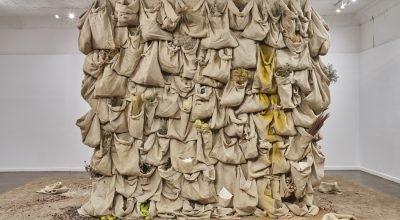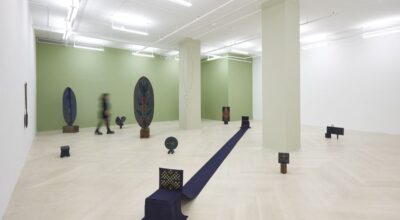
Nari Ward:we The People
[et_pb_section bb_built=»1″][et_pb_row][et_pb_column type=»4_4″][et_pb_text _builder_version=»3.2.2″]
Since the early 1990s, Nari Ward (b. 1963, St. Andrew, Jamaica) has produced sculptures by accumulating staggering amounts of mundane materials and repurposing them in surprising ways. His approach draws from a variety of art historical and folk traditions and reflects the material textures of Harlem, where he has lived and worked for the past twenty-five years.
Shopping carts, strollers, garbage bags, fire hoses, bits of furniture, and debris from crumbling buildings reflect the physical and socioeconomic realities of Ward’s neighborhood at that time. He transforms these quotidian materials into intricate, haunting objects and environments that draw on a diverse lineage of forms, from American folk art to Post-Minimalist painting and assemblage sculpture by African-American artists of the 1960s and ’70s. Evoking spiritual traditions and places of worship as well as the ongoing trauma of the AIDS crisis and crack epidemic in New York, these works powerfully capture the landscape of Harlem at a moment of profound change.
Until May 26, 2019, The New Museum presents his first museum survey in New York, which brings together works spanning the artist’s twenty-five-year career. Curated by Gary Carrion-Murayari, Massimiliano Gioni, and Helga Christoffersen, Nari Ward: We the People features over thirty sculptures, paintings, videos, and large-scale installations, including his most iconic sculptures alongside a number of works that have not been seen in New York since they were originally created. The exhibition demonstrates Ward’s status as a key bridge between generations of American sculptors and a vital advocate for art’s capacity to address today’s most urgent issues.
[/et_pb_text][et_pb_image _builder_version=»3.2.2″ src=»https://artishockrevista.com/wp-content/uploads/2019/05/4TH-FLOOR_VIEW-3.jpg» show_in_lightbox=»on» align=»center» alt=»Nari Ward, Carpet Angel, 1992, carpet, plastic bags, plastic bottles, carpet runner, springs, wood screws, and rope, 230 x 238 x 36 in (584.2 x 604.5 x 91.4 cm). “Nari Ward: We the People,” 2019. Exhibition view: New Museum, New York. Photo: Maris Hutchinson / EPW Studio» title_text=»Nari Ward, Carpet Angel, 1992, carpet, plastic bags, plastic bottles, carpet runner, springs, wood screws, and rope, 230 x 238 x 36 in (584.2 x 604.5 x 91.4 cm). “Nari Ward: We the People,” 2019. Exhibition view: New Museum, New York. Photo: Maris Hutchinson / EPW Studio» /][et_pb_image _builder_version=»3.2.2″ src=»https://artishockrevista.com/wp-content/uploads/2019/05/2ND-FLOOR_VIEW-11.jpg» show_in_lightbox=»on» align=»center» alt=»“Nari Ward: We the People,” 2019. Exhibition view: New Museum, New York. Photo: Maris Hutchinson / EPW Studio» title_text=»“Nari Ward: We the People,” 2019. Exhibition view: New Museum, New York. Photo: Maris Hutchinson / EPW Studio» /][et_pb_image _builder_version=»3.2.2″ src=»https://artishockrevista.com/wp-content/uploads/2019/05/3RD-FLOOR_VIEW-1.jpg» show_in_lightbox=»on» align=»center» alt=»Nari Ward, We the People, 2011, shoelaces, 96 x 324 in (243.8 x 594.4 cm). “Nari Ward: We the People,” 2019. Exhibition view: New Museum, New York. Photo: Maris Hutchinson / EPW Studio» title_text=»Nari Ward, We the People, 2011, shoelaces, 96 x 324 in (243.8 x 594.4 cm). “Nari Ward: We the People,” 2019. Exhibition view: New Museum, New York. Photo: Maris Hutchinson / EPW Studio» /][et_pb_text _builder_version=»3.2.2″]
Ward researches specific histories and sites to uncover connections among disparate communities and to explore the tension between tradition and transformation. Seeking out the personal and social narratives embedded in materials, he conceives of his sculptures as tools for articulating relationships between people. Over the past three decades, he has addressed topics such as historical memory, political and economic disenfranchisement, racism, and democracy in an effort to express both the tenuousness and the resilience of community. He moved to the United States from Jamaica as a child and frequently articulates his experience of migration—as well as the diasporic experiences of many other New Yorkers—in his work.
The beginning of Ward’s career in the early 1990s, moreover, coincided with an expansion of the global art world and a proliferation of international biennials. As a young artist, Ward participated in the 1993 Venice Biennale with Exodus (1993), an ambitious installation with roots in the social changes he observed in Harlem, which nonetheless echoes the reality of refugees around the world. As Ward has embraced an international context for his sculpture, he has increasingly reflected on historical patterns of migration and displacement, particularly those tied to slavery, and on the rhetoric of inclusion and exclusion that forms the foundation of America.
The exhibition includes several key early works, such as the large-scale environments Amazing Grace and Hunger Cradle (both 1993), which Ward made and exhibited in an abandoned firehouse. That same year, Ward had his first institutional solo exhibition at the New Museum where he exhibited a dramatic, large sculpture, Carpet Angel (1992). Like other works from this period, Carpet Angel employs discarded objects to create a sense of renewal or transcendence from humble material origins. This presentation marks the first time the work has been exhibited since its debut.
[/et_pb_text][et_pb_image _builder_version=»3.2.2″ src=»https://artishockrevista.com/wp-content/uploads/2019/05/2ND-FLOOR_VIEW-4.jpg» show_in_lightbox=»on» align=»center» alt=»Nari Ward, Iron Heavens, 1995, oven pans, ironed sterilized cotton, and burnt wooden bats, 140 x 148 x 48 in (355.6 x 375.9 x 121.9 cm). “Nari Ward: We the People,” 2019. Exhibition view: New Museum, New York. Photo: Maris Hutchinson / EPW Studio» title_text=»Nari Ward, Iron Heavens, 1995, oven pans, ironed sterilized cotton, and burnt wooden bats, 140 x 148 x 48 in (355.6 x 375.9 x 121.9 cm). “Nari Ward: We the People,” 2019. Exhibition view: New Museum, New York. Photo: Maris Hutchinson / EPW Studio» /][et_pb_image _builder_version=»3.2.2″ src=»https://artishockrevista.com/wp-content/uploads/2019/05/2ND-FLOOR_VIEW-8.jpg» show_in_lightbox=»on» align=»center» alt=»Nari Ward, Blue Window-Brick Vine, 1993, mixed mediums, 91 x 96 x 37 1/2 in (231.1 x 243.8 x 95.3 cm). “Nari Ward: We the People,” 2019. Exhibition view: New Museum, New York. Photo: Maris Hutchinson / EPW Studio» title_text=»Nari Ward, Blue Window-Brick Vine, 1993, mixed mediums, 91 x 96 x 37 1/2 in (231.1 x 243.8 x 95.3 cm). “Nari Ward: We the People,” 2019. Exhibition view: New Museum, New York. Photo: Maris Hutchinson / EPW Studio» /][et_pb_image _builder_version=»3.2.2″ src=»https://artishockrevista.com/wp-content/uploads/2019/05/3RD-FLOOR_VIEW-4_SCALE.jpg» show_in_lightbox=»on» align=»center» alt=»Nari Ward, Exodus, 1993, mixed mediums. “Nari Ward: We the People,” 2019. Exhibition view: New Museum, New York. Photo: Maris Hutchinson / EPW Studio» title_text=»Nari Ward, Exodus, 1993, mixed mediums. “Nari Ward: We the People,” 2019. Exhibition view: New Museum, New York. Photo: Maris Hutchinson / EPW Studio» /][et_pb_text _builder_version=»3.2.2″]
Ward has continued to look to Harlem for inspiration in the years following, even as the neighborhood undergoes dramatic changes. Gentrification has intensified inequality in Harlem and across many communities, rendering housing, safety, and financial stability inaccessible for longtime residents, particularly people of color.
In his more recent work, Ward directly addresses complex political and social realities that resonate on both a local and a national level, reflecting the profound changes gentrification has brought to Harlem and the increasingly fractured state of democracy in the United States. He uses language, architecture, and a variety of sculptural forms to reflect on racism and power, migration and national identity, and the layers of historical memory that comprise our sense of community and belonging.
[/et_pb_text][et_pb_image _builder_version=»3.2.2″ src=»https://artishockrevista.com/wp-content/uploads/2019/05/3RD-FLOOR_VIEW-8.jpg» show_in_lightbox=»on» align=»center» alt=»Nari Ward, Glory, 2004, oil barrel, fluorescent and ultraviolet tubes, computer parts, DVD, parrot audio, Plexiglas, fan, camera casing elements, paint cans, cement, towels, and rubber roofing membrane, dimensions variable. “Nari Ward: We the People,” 2019. Exhibition view: New Museum, New York. Photo: Maris Hutchinson / EPW Studio» title_text=»Nari Ward, Glory, 2004, oil barrel, fluorescent and ultraviolet tubes, computer parts, DVD, parrot audio, Plexiglas, fan, camera casing elements, paint cans, cement, towels, and rubber roofing membrane, dimensions variable. “Nari Ward: We the People,” 2019. Exhibition view: New Museum, New York. Photo: Maris Hutchinson / EPW Studio» /][et_pb_image _builder_version=»3.2.2″ src=»https://artishockrevista.com/wp-content/uploads/2019/05/4TH-FLOOR_VIEW-5.jpg» show_in_lightbox=»on» align=»center» alt=»Nari Ward, T.P. Reign Bow, 2012, wood, blue tarp, brass grommets, zippers, human hair, and taxidermy fox, 224 x 156 x 270 in (569 x 396.2 x 685.8 cm). “Nari Ward: We the People,” 2019. Exhibition view: New Museum, New York. Photo: Maris Hutchinson / EPW Studio» title_text=»Nari Ward, T.P. Reign Bow, 2012, wood, blue tarp, brass grommets, zippers, human hair, and taxidermy fox, 224 x 156 x 270 in (569 x 396.2 x 685.8 cm). “Nari Ward: We the People,” 2019. Exhibition view: New Museum, New York. Photo: Maris Hutchinson / EPW Studio» /][et_pb_image _builder_version=»3.2.2″ src=»https://artishockrevista.com/wp-content/uploads/2019/05/4TH-FLOOR_VIEW-8_SIGN-I.jpg» show_in_lightbox=»on» align=»center» alt=»Nari Ward, Apollo/Poll, 2017, steel, wood, vinyl, and LED lights, 360 x 144 x 48 in (914.4 x 365.8 x 121.9 cm). “Nari Ward: We the People,” 2019. Exhibition view: New Museum, New York. Photo: Maris Hutchinson / EPW Studio» title_text=»Nari Ward, Apollo/Poll, 2017, steel, wood, vinyl, and LED lights, 360 x 144 x 48 in (914.4 x 365.8 x 121.9 cm). “Nari Ward: We the People,” 2019. Exhibition view: New Museum, New York. Photo: Maris Hutchinson / EPW Studio» /][et_pb_text _builder_version=»3.2.2″]
Imagen destacada: Nari Ward, Amazing Grace, 1993, approx. 300 baby strollers and fire hoses, dimensions variable. “Nari Ward: We the People,” 2019. Exhibition view: New Museum, New York. Photo: Maris Hutchinson / EPW Studio
[/et_pb_text][/et_pb_column][/et_pb_row][/et_pb_section]
También te puede interesar
Galleria Continua Abre Sede en Cuba, Carlos Garaicoa su Residencia
Galleria Continua, con espacios en San Gimignano, Beijing y Les Moulins, abre ahora una nueva sede en La Habana, convirtiéndose así en la primera galería extranjera en Cuba. Galleria Continua ha convertido el antiguo cine Águila…
Solange Pessoa:longilonge
Ballroom Marfa presents the first solo museum exhibition in the United States of Brazilian artist Solange Pessoa (Ferros, 1961). Pessoa’s practice is deeply rooted in land, human and natural history. In this focused exhibition,...
JOHANNA UNZUETA: NATURALIST
In "Naturalist", Johanna Unzueta's (b. 1974, Santiago, Chile) first solo exhibition at Casey Kaplan, the artist draws from the natural world and the balance between the earth and its living counterparts. In an intimate exploration...



